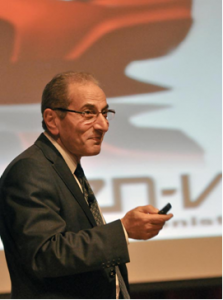Envisioning a world with all-electric cars that don’t crash, a General Motors (GM) official met with TTI employees and two Texas A&M University engineering departments Jan. 31 prior to a presentation he gave that evening at the Annenberg Presidential Conference Center at the George Bush Presidential Library.

Nady Boules, the director of GM’s Electrical and Controls Integration Lab, told those attending his presentation — entitled General Motors Advanced Vehicle and Transportation Research — the cars of the future will be “energized by electricity and hydrogen, powered by internal motors, controlled electronically and should be connected.”
Boules’ 90-minute presentation envisioned a new fleet of cars that are completely safe and have zero emissions.
Boules was invited to speak by TTI Agency Director Dennis Christiansen. Both are members of the Intelligent Transportation Society of America Board of Directors. “Because of the commitment of General Motors in turning science fiction into reality, we have a sense of what our world will look like,” Christiansen said of the presentation. “This is a look forward, and makes us realize the scope of the dramatic changes we are likely to see in our lifetime.”
Boules told his audience that, following the company’s restructuring two years ago, GM is starting the century with a “new vigor.” He said the growing population, especially around major cities, is a threat to life and safety because of automobile air pollution and crashes. He predicted a quick depletion of our oil supply and characterized the 35,000 traffic deaths per year in the United States as “unacceptable.”
Regarding the shift to all-electric vehicles, Boules said that because battery powered engines do not yet reach the preferred three-to-four hundred mile range per charge, hybrid engines (a combination of a battery and an internal combustion motor) will be used in the interim.
As for safety, Boules said that accident prevention is GM’s major goal and receives the company’s constant attention. “In our view, [improved safety] will happen directly by introducing building blocks that are meant to enhance the safety of the vehicle. If you think of [a collection of safety features], we are marching steadily towards a world where we have cars that do no crash.”
Boules anticipates a time when all vehicles will be equipped with a series of onboard computers that create a 360-degree sensing capability around the vehicle’s perimeter. Onboard radar systems, steering cameras and ultrasonic devices will be connected with other vehicle’s systems to eventually allow the car to
- steer itself into the safest lane to avoid a collision,
- alert other cars around it to slow down and
- notify the driver if the car veers out of its lane.
In order for it all to work, Boules added, the computers must reliably predict other vehicle behaviors during specific maneuvers.
“If we can get to cars that do not crash, we can create radically different, lower-mass, higher efficiency vehicles. If you have a lightweight shell, energy consumption will be less,” he said.